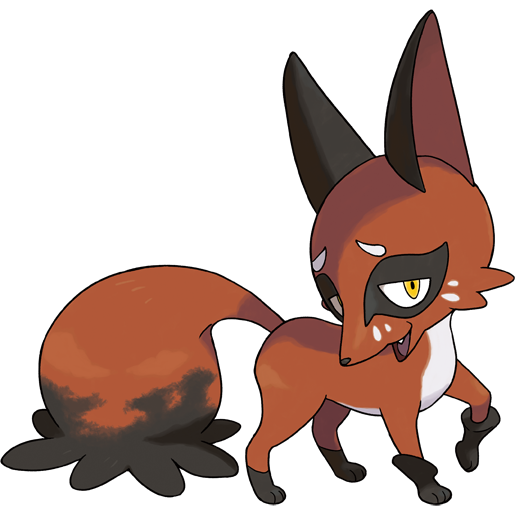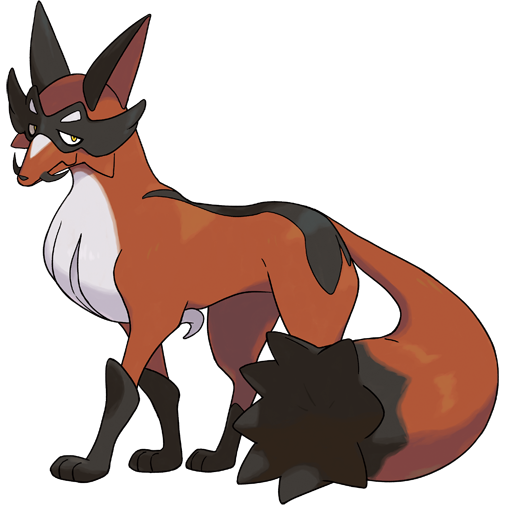In this recurring series, I’ll analyze the origins of Pokémon designs, their culture, and their historical allusions to British culture.
Today we will be analyzing the regional fox Pokémon Nickit and its evolution.
Nickit

Nickit is classified as a “Fox Pokémon”, sharing that classification with the Vulpix and Fennekin lines. Unlike them however, it is a Dark-type rather than fire. While it shares the same reddish hue, it has other characteristics that distinguish itself.
Its name derives from the phrase “nick it”, where “nick” comes from British slang as an equivalent to stealing. The word “kit” can mean a baby fox.
As an aside and being named Nick myself, I do not appreciate this slang.
The criminal allusions go behind its name, they also tie into the Pokémon’s design. Its front paws appear to be wearing boots or gloves that allow it to move silently. Its tail is large and split at the end. The large size of its tail resembles a bag that may be used to hold stolen goods, and its split tail resembles a mop or broom to wipe away any evidence it was at the crime scene. The black marks on its tail could even be fingerprint dust that its cleaning. Its Pokédex entries confirm:
Aided by the soft pads on its feet, it silently raids the food stores of other Pokémon. It survives off its ill-gotten gains.
Cunning and cautious, this Pokémon survives by stealing food from others. It erases its tracks with swipes of its tail as it makes off with its plunder.
Nickit’s origins come from the red fox, a species that is common in Great Britain as well as many other parts of the world. They’re considered among the worst invasive species due to its quick adaptability to new environments, where it causes havoc in local ecosystems.
In British culture, they have long been seen as clever or tricksters. The word “outfox” was coined to mean “outsmart”.
While the red fox clearly has red fur, the silver fox is a melanistic form of the red fox which causes the fur to become dark. Given the rare occurrence of silver foxes, their fur was highly sought after among aristocratic folks in much of Europe. It’s not surprising that Nickit’s shiny has a gray hue, as silver foxes were real life shiny foxes.
Thievul

Nickit evolves into Thievul, an adult fox. Its ‘costume’ continues to develop to demonstrate that it is not a common thief, but a sophisticated one. The black fur around its eyes has evolved into a domino mask, a small mask with origins in Italian masquerade culture. It gives the wearer an air of mystique. It also has an English mustache, thin and pointed upwards. Adding to its aristocratic style is its tufts of fur extending out and curling down, resembling a cravat.
Its name seems to be a combination of “thief” and “vulpine”. A vulpine is a species in the genus “vulpes”, the same name origin of Vulpix.
It secretly marks potential targets with a scent. By following the scent, it stalks its targets and steals from them when they least expect it.
With a lithe body and sharp claws, it goes around stealing food and eggs. Boltund is its natural enemy.
The Pokédex entries include a mention of its rivalry with Boltund. Foxes have a history with the aristocratic culture of England since the sixteenth century, where the activity of fox hunting began. Often the hunters would follow a number of scent hounds as they chased the animals. The practice has recently been banned.
Like with Nickit, Thievul’s shiny has silver fur based on the silver fox.
Conclusion
About a decade after World War II, Dmitry Belyayev from the Soviet Union began an experiment to domesticate foxes through selective breeding. While foxes are not common pets, the domesticated foxes in the experiment became less aggressive and were eager for human companionship much like dogs.
Nickit and Thievul would be a nuisance in the wild, stealing your food and eggs. However I can imagine they would be useful companions if captured.
Let us know your thoughts on this fox-based Pokémon line, either in the comments or in our Discord server!










